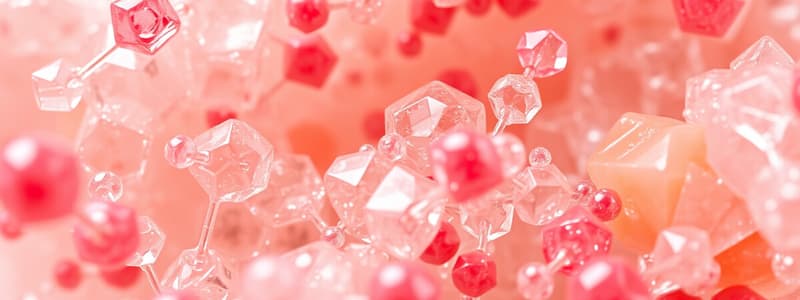Podcast
Questions and Answers
What demonstrates the Tyndall Effect?
What demonstrates the Tyndall Effect?
- Refraction of light in a solid medium
- Scattering of light by particles in a colloid (correct)
- Visible light passing through a crystal
- Absorption of light by colored solutions
What is a characteristic of physical changes?
What is a characteristic of physical changes?
- They always produce a gas
- They can often be reversed (correct)
- Chemical bonds are broken
- New substances are formed
Which of the following processes is an example of melting?
Which of the following processes is an example of melting?
- Sugar dissolving in water
- Salt crystallizing from saturated solution
- Water freezing at 0 degrees Celsius
- Ice turning into water when heated (correct)
Brownian motion is defined as:
Brownian motion is defined as:
Which property depends on the type of material rather than its quantity?
Which property depends on the type of material rather than its quantity?
What happens during solidification?
What happens during solidification?
Which of the following is a property of colloids?
Which of the following is a property of colloids?
What occurs during the chemical change represented by the equation $2H + O > H_2O$?
What occurs during the chemical change represented by the equation $2H + O > H_2O$?
Which of the following describes nematic liquid crystals?
Which of the following describes nematic liquid crystals?
Which of the following is not a characteristic of solutions?
Which of the following is not a characteristic of solutions?
What type of crystal system is represented by sodium chloride?
What type of crystal system is represented by sodium chloride?
What distinguishes a suspension from a colloid?
What distinguishes a suspension from a colloid?
Which component of a solution is present in the lesser amount?
Which component of a solution is present in the lesser amount?
Which of the following is an example of a colloid?
Which of the following is an example of a colloid?
In which type of liquid crystal are the molecular arrangements akin to soap?
In which type of liquid crystal are the molecular arrangements akin to soap?
Which of these is considered the 'universal solvent'?
Which of these is considered the 'universal solvent'?
What distinguishes colloids from solutions?
What distinguishes colloids from solutions?
Which of the following is a characteristic of suspensions?
Which of the following is a characteristic of suspensions?
Which of the following is an example of a colloid?
Which of the following is an example of a colloid?
What type of property is solubility considered?
What type of property is solubility considered?
Which statement about the Tyndall effect is correct?
Which statement about the Tyndall effect is correct?
Which of the following substances is likely to be found in a suspension?
Which of the following substances is likely to be found in a suspension?
What type of crystal system does iodine fall under?
What type of crystal system does iodine fall under?
Which of these is NOT an extensive property?
Which of these is NOT an extensive property?
Study Notes
Types of Crystals
- Rhombic Iodine and Monoclinic Sucrose are examples of distinct crystal structures.
- Six distinct crystal systems: Cubic, Tetragonal, Hexagonal.
Colloids
- Contain particles larger than those in solutions but smaller than in suspensions; e.g., milk.
- Tyndall Effect demonstrates light scattering by colloidal particles.
- Characteristics:
- Solubility varies (soluble in colloids, less so in suspensions).
- Optical activity, pH, color, and concentration all applicable.
- Examples include milk (colloid) and mud in water (suspension).
Properties of Matter
- Two categories: Extensive/Extrinsic and Intensive/Intrinsic properties.
- Extensive properties (e.g., volume, weight, pressure) depend on the amount of substance.
- Intensive properties (e.g., boiling point, temperature, color) are independent of the amount.
Physical Changes
- Involve phase changes without altering chemical composition.
- Example: Transition of liquid water to ice.
- Brownian Motion describes the random movement of particles in a fluid caused by collisions with molecules.
Changes in Matter
- Physical changes include melting (from liquid to solid), freezing (caused by cooling), and solidification (can occur from chemical reactions).
- Melting Point: Specific temperature at which a solid transitions to a liquid.
Chemical Changes
- Result in new substances through a change in chemical composition.
- Involves breaking and forming chemical bonds; e.g., 2H + O → H2O.
Solution Characteristics
- Solution: Uniform mixture of solute and solvent; e.g., salt in water.
- Solvent: Dissolves the solute, known as the "universal solvent" (water).
- Solute: The smaller amount of substance that is dissolved.
Types of Liquid Crystals
- Two main types:
- Smectic: Soap or grease-like properties.
- Nematic: Thread-like properties.
Suspensions
- Homogeneous dispersion where solid particles are dispersed in a liquid or gas but are not dissolved.
- Example: Mud in water.
Studying That Suits You
Use AI to generate personalized quizzes and flashcards to suit your learning preferences.
Related Documents
Description
Test your knowledge on the properties of matter, types of crystals, and the characteristics of colloids. This quiz will cover distinct crystal structures, the differences between extensive and intensive properties, and the nature of physical changes. Prepare to dive deep into these fundamental concepts in chemistry!



